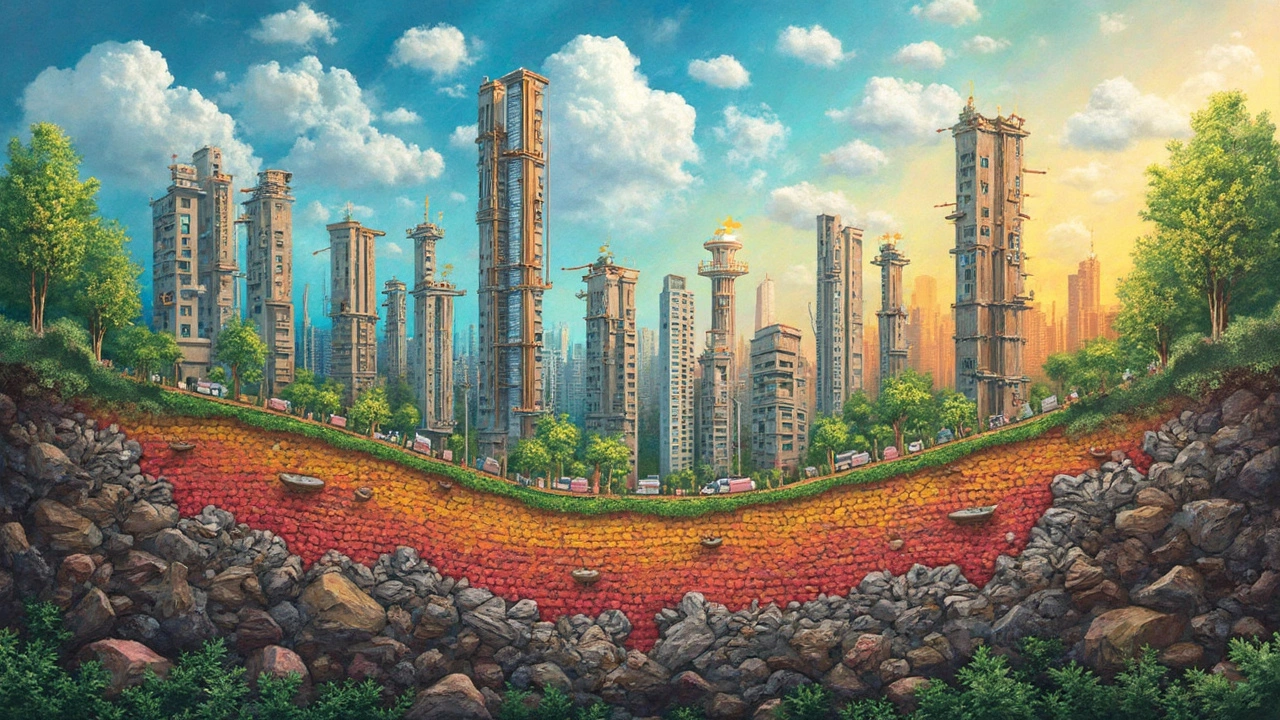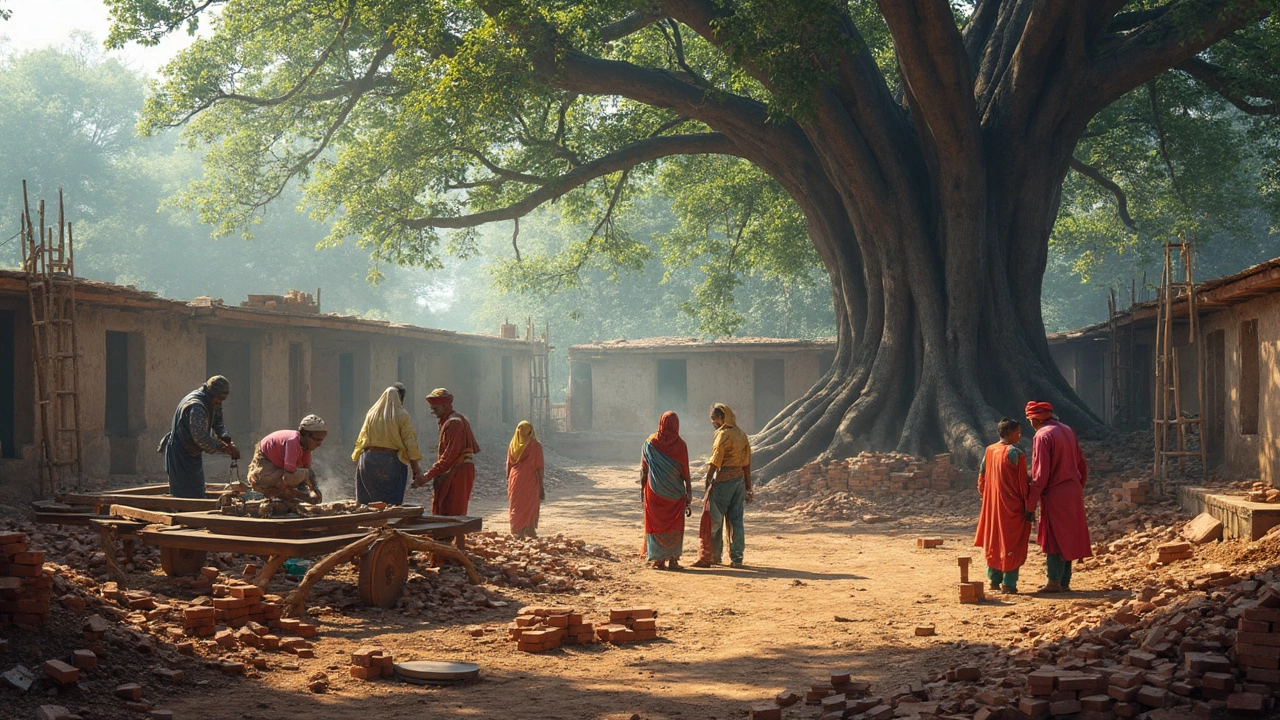Ever wondered what stands behind those skyscrapers, bridges, and roads we see every day? It's all about the raw materials used in construction. These materials are more than just building blocks; they're the foundation of society. When you walk into an office building or live in your house, you're surrounded by these materials, even if you don't realize it. Each has its role and specific advantages, making them irreplaceable in their own ways.
Let's start with wood—an incredibly versatile material. You might not believe it, but wood has been a go-to since ancient times. Its strength-to-weight ratio is pretty impressive, which might be why your cozy wooden floor or that chic wooden ceiling beam looks so darn good while holding everything up. Wood's natural appearance also makes it a favorite for designers. But did you know that woods like bamboo are used for environmental reasons since they grow quickly and help combat deforestation?
- The Versatility of Wood
- Essential Properties of Concrete
- The Strength of Steel
- The Importance of Bricks
- How Glass Plays a Role
The Versatility of Wood
Diving into wood, it's easy to see why it tops the list. Wood has been a staple in construction for millennia, primarily because of its versatility and sustainability. It's like the chameleon of building materials, able to adapt and fit into so many roles. Fancy a wooden deck, anyone? Not only does it add charm, but it’s also a sustainable choice.
What makes wood special is its amazing strength-to-weight ratio. This means you can build something strong and stable without needing a ton of material. Plus, wood's insulation properties are an added bonus. Ever snuggled up in a log cabin during winter? It's that natural insulation keeping you warm.
Types of Wood in Construction
There are several types of wood used in building, and understanding these can help you make the right choice for your project:
- Softwoods like pine and cedar are commonly used for framing houses and making furniture. They're easy to work with and generally more affordable.
- Hardwoods such as oak and maple are your go-to for flooring and high-end furniture. They offer durability and a richer appearance.
- Engineered wood, including plywood and MDF, combines various wood types to create consistent strength and appearance.
Here’s an interesting tidbit: Wood is a renewable resource, especially when sourced from sustainably managed forests. This aligns with global efforts to reduce carbon footprints. But remember, while wood is versatile, it does require maintenance. Treat it right, and it will last for decades!
Essential Properties of Concrete
Concrete is like the superhero of the construction world. Why? Because it's got this unique mix of strength, versatility, and durability that's hard to beat. At its core, concrete is a blend of aggregates, cement, and water, and believe it or not, this stuff gets stronger over time.
Strength and Durability
One of the reasons concrete is a favorite in construction is its impressive compressive strength. That's a fancy way of saying it can withstand tons of weight, which is perfect for those towering buildings and endless highways. It's what makes it essential for structures needing to hold up heavy loads.
But it's not just about strength. Concrete's durability means it can withstand environmental stressors, like harsh weather or chemical exposure, without falling apart. So, when you see buildings surviving storms or bridges standing tall in salty coastal lines, that's concrete doing its job.
Versatility
Concrete isn't one-size-fits-all, and that's a big part of its charm. You can adjust its formula to suit different needs—like making it more fluid for complex shapes or adding fibers for extra strength. Ready-mix concrete trucks are like mobile chemistry labs, delivering the perfect mix right to your project site.
| Type of Concrete | Primary Use |
|---|---|
| High-Strength | Skyscrapers, Bridges |
| Lightweight | Building Panels |
Sustainability
In today's world, sustainability is key, and cement production, a key component of concrete, has its environmental challenges. Innovations like using fly ash or slag instead of traditional cement are paving the way for more eco-friendly options. Plus, concrete is great for energy efficiency—buildings made with it often require less heating and cooling, which is a win for the planet and your wallet.
Whether it's shaping unique architectural designs or holding up infrastructure projects, concrete proves time and time again why it's an indispensable raw material in the construction industry.

The Strength of Steel
Steel is kind of the superstar in the construction world. Its secret weapon? A combination of strength and flexibility that ticks all the boxes from skyscrapers to bridges. Steel is often touted for its ability to support massive loads without cracking under pressure—literally. Have you ever thought about how those towering urban giants stay upright? Steel's the silent force behind it all.
One reason steel is so popular is its durability. Unlike some other materials, it doesn't warp, rot, or twist over time. So, it’s like the dependable friend who's always there for you, come rain or shine. And let's talk about its recyclability—steel’s an eco-warrior! Nearly 98% of structural steel is recycled. It's a long-lasting material that cares about the planet, too.
The Role of Steel in Modern Buildings
From the frames that outline modern architecture to the internal structures we rarely see, steel’s importance is undeniable. It’s lightweight compared to its strength, meaning architects can get creative without worrying about hefty materials that might compromise a design or, worse, safety.
| Property | Value |
|---|---|
| Tensile Strength | 400-500 MPa |
| Recyclability | 98% |
Benefits of Steel in Construction
- Durability: It handles extreme conditions without breaking a sweat.
- Flexibility: Steel adapts easily to seismic activity, making it safer in earthquake-prone areas.
- Sustainability: A champion recycler, contributing to eco-friendly building practices.
And there you have it. Steel isn’t just about appearance and strength. It's about reliability, versatility, and an eye toward a sustainable future. Next time you're marveling at the city skyline, remember the unseen hero that makes it all possible.
The Importance of Bricks
When you think of construction, bricks probably pop into your head almost immediately. And for good reason—they're one of the oldest building materials known to mankind, tracing back thousands of years. These humble blocks aren't just about nostalgia; they're crucial for modern building for their durability and thermal efficiency.
Bricks shine brightest in their role in providing sustainable and energy-efficient buildings. The thermal mass of bricks keeps buildings warmer in the winter and cooler in the summer, which can lower energy costs quite a bit. That's a win for both the planet and your wallet.
Why Bricks Matter
So, why are bricks so important? For starters, they’re incredibly strong. Though they might seem small, when layered and mortared together, they form walls that can withstand tons of pressure. It's why ancient structures built with bricks still stand today—they can truly stand the test of time.
The aesthetic appeal of bricks is another point worth noting. From rustic red to modern shades, they fit well with both classical and contemporary designs, offering flexibility in design aesthetics. Plus, they're low maintenance and fire-resistant, adding to their practical charm.
Interesting Brick Stats
| Fact | Description |
|---|---|
| Weight | An average brick weighs around 4.5 pounds. |
| Production | Globally, billions of bricks are produced yearly, supporting massive construction industries. |
| Longevity | Recent studies suggest that brick pathways can last up to 100 years with proper care. |
These enduring characteristics are why bricks continue to be an essential construction material. Whether building a modest home or a towering skyscraper, bricks bring reliability, sustainability, and style to the table. They're the unsung heroes in the staggering world of construction.

How Glass Plays a Role
When you think about construction, glass might not be the first thing that comes to mind, but it's a game-changer, especially in modern buildings. Ever noticed how newer skyscrapers seem to shine? That's glass in action. It's not just about aesthetics—glass plays a critical role in energy efficiency and creating comfortable environments inside these structures.
So, what's the deal with glass? Well, one of its top perks is letting natural light flood into spaces, cutting the need for electric lighting. Plus, with advancements in tech, we're seeing the rise of materials like smart glass. This type of glass can adjust its opacity based on sunlight, helping reduce cooling costs in hot climates.
From Windows to Facades
Glass is everywhere in a building—from windows to entire facades. Gone are the days when glass was just fragile and easily breakable. Now, we have tempered glass, which can withstand impacts much better than ordinary glass. That's why you see it in railings, doors, and even as structural elements in some daring designs.
There's also laminated glass, designed with a plastic layer sandwiched between glass layers. This gives it safety properties that make it a top pick for areas requiring high security. Building standards often require safety glass in places prone to human impact—like shower doors or storefronts.
Innovative Uses and Sustainability
For the planet-friendly folks, glass is recyclable, making it a sustainable option compared to other building materials. Recycled glass can be transformed into new products, reducing the demand for raw materials and energy use. Fun fact: nearly all glass used in construction can be recycled endlessly without losing quality. Talk about a win-win!
To sum it up, glass in construction does more than just let in light. It's about improving energy efficiency, enhancing safety, and contributing to a sustainable future. Next time you step inside a building, think of the raw materials that make it what it is—including the surprisingly versatile glass.

Written by Fletcher Abernathy
View all posts by: Fletcher Abernathy